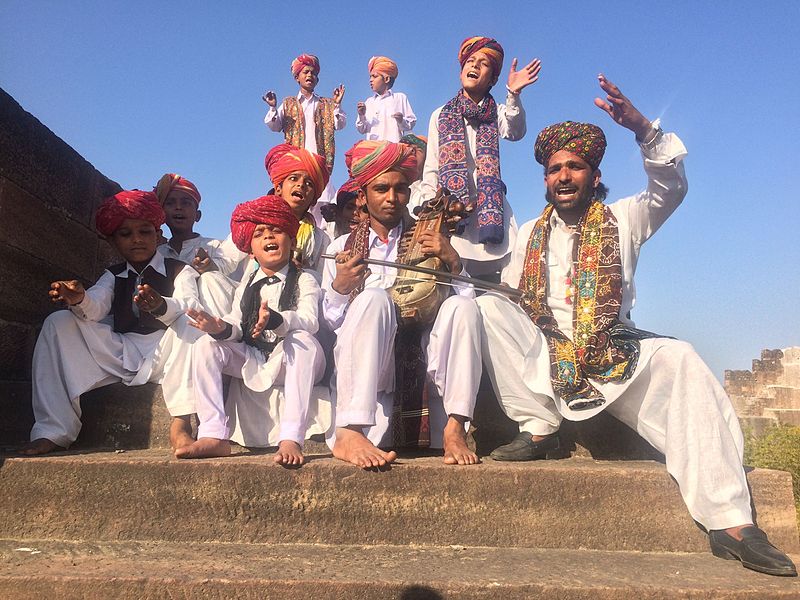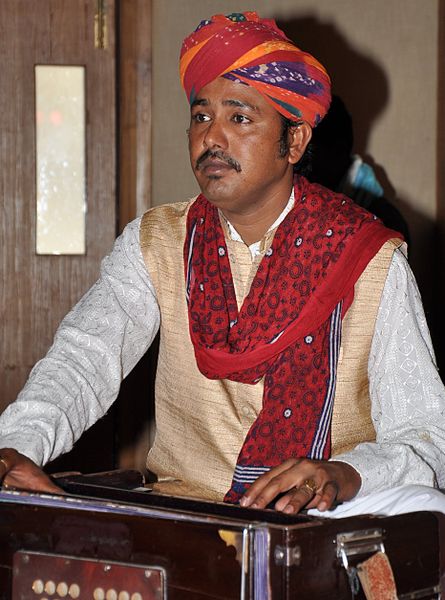At the Forefront of Rajasthani Folk Music – Mame Khan Posted by Rachael on Nov 14, 2018 in Hindi Language, Uncategorized
As you may know from my previous post on the topic, I’m a big fan (प्रशंसक/prashansak) of Coke Studio. I especially enjoy folk music (लोक संगीत/lok sangeet) as it is performed on the show and recently came across a folk artist from Rajasthan, Mame Khan (ममे खान), who is remarkable for his talent, unabashed dedication to traditional vocal styles and lyrics and impassioned and exuberant performances. In addition to reading this blog, if you’d like to learn more about this artist you can also check out this article about Khan’s rise to fame and success in the music industry. In this blog, I will discuss Khan’s background and showcase one of his songs, “Chaudhary,” (चौधरी) which he performed on Coke Studio alongside the renowned film score composer, singer, songwriter and music director, Amit Trivedi (संगीतकार/sangeetkaar=musician).
As it states in the aforementioned BBC Hindi article about this artist, written by Shrabanti Chakravarty, Mame Khan emerged from the “soil of Rajasthan” to ascend the stage at Coke Studio (“राजस्थान की मिट्टी से कोक स्टूडियो तक/Rajasthan ki mitthi se Coke Studio tak”), a meteoric rise that is astonishing to no one who has witnessed his performances. Unsurprisingly, Khan’s upbringing was enriched with music as he is part of the Manganiar lineage (मंगनियार घराना/Manganiar gharaanaa), a familial network of musicians who are famous for their contributions to Rajasthani folk music. Manganiars are a network of Muslim hereditary musicians who reside today in the province of Sindh, Pakistan and in the districts of Rajasthan along the border with Sindh. Previously, they were supported in their trade by patrons (जजमान/jajmaan), such as wealthy landlords, merchants and aristocrats, who were often part of the dominant Rajput (क्षत्रिय/Kshatriya=Rajputs are considered part of the overarching “warrior” caste) caste. Manganiar musicians would serve their patrons by performing especially during traditional times of celebration, such as on the occasion of a birth (जन्मदिन/janmadin) or a wedding (शादी/shaadi or विवाह/vivaah). Considering the geographic region in which they are concentrated, it is no surprise that most of their repertoire is in the regional languages of Sindhi and Marwari.
Because their trade (शिल्प/shilp) has been passed from generation to generation (पीढ़ी/peerhi) over centuries, songs (गाना/gaanaa, plural: गाने/gaane) that were created and popularized hundreds of years ago are still sung today and function as a historical record of the Thar desert and Sindh, as well as the musicians themselves and their patrons. If you go to the city of Jaisalmer today, in the far western region of Rajasthan, you will find a thriving community of Manganiars who have been active for hundreds of years. Even though the Manganiars are themselves Muslim (मुसलमान/musalmaan), many, if not most, of their songs celebrate Hindu deities, they often perform on Hindu holidays such as Holi and Diwali and they regularly invoke the Hindu God Krishna before a performance as a sort of patron God. Today, many Manganiars have eschewed the label “Manganiar,” which is considered derogatory and indicative of a low-caste beggar in some circles, and have begun calling themselves “Merasi,” which means “musicians” or “keepers of the stories” and acknowledges their essential role as oral historians (मौखिक इतिहासकार/maukhik itihaaskaar) and artists (कलाकार/kalaakaar) who have served the public for centuries. Of course, there are other members of this community, such as Khan himself, who continue to proudly declare their identity as “Manganiar,” despite the unjustly negative connotations it may hold for some.
Khan himself is among the 14th generation (१४वीं पीढ़ी) of this clan and has taken his role as a leader of his community seriously as he seeks to achieve betterment for this network of musicians. To illustrate just how central music was to Khan growing up in a Manganiar family, the author of the article mentions a saying (कहावत/kahaavat) that is popular (लोकप्रिय/lokpriya) in the Manganiar community: “यहां का बच्चा अगर रोता भी है तो सुर में रोता है” (Even if a child from around here cries, he does so with a tune/in tune). Khan explains that the first person who inspired him in his life as a budding musician was his father, Rana Khan, whose disciple (मुरीद/mureed) he later became. Further, Khan mentions how music was part of every aspect of his life growing up, which contributed to his appreciation for this art form and developed his innate talents as a musician: “मंगनियार घराने में हर छोटा बच्चा संगीत के माहौल में बड़ा होता है. खाते-पीते उठते-बैठते हम संगीत को जानते हैं, सीखते हैं लेकिन इसकी कोई डिग्री नहीं होती” (In the Manganiar community, every small child grows up in an atmosphere of music. Eating, drinking, getting up, sitting down – we come to know music, we learn it, but there is no degree for this). Khan further explains that one of the ways he seeks to achieve progress within this community and preserve its centuries-old store of knowledge and songs is by writing down the lyrics to the songs he has learnt orally (मौखिक रूप से) according to the community’s traditions (रीति/reeti).
Previous to his experience (अनुभव/anubhav) performing on Coke Studio, Khan had sung for the film scores of movies such as “No One Killed Jessica,” “Luck by Chance” and “I am Kalam,” but he did not achieve widespread fame (प्रसिद्धी/prasiddhi or शोहरत/shohrat) until his appearance alongside Trivedi on Coke Studio. Khan attributes the blossoming of his current fame to his savvy use of social media and his appearance on the well-known show, stating, “मेरा मानना है कि एक कलाकार के लिए सिर्फ़ एक कलाकार होना पर्याप्त नहीं. उसके लिए आपको सोशल मीडिया में आना बहुत ज़रूरी है. मेरा कोई भी गाना 14 साल पहले मेरे गांव में 3000 लोग सुनते थे लेकिन आज वही गाना लाखों लोग सुनते हैं और मैं चाहता हूं कि मेरा संगीत सब सुनें और समझें और वही काम कोक स्टूडियो ने करके दिखाया” (I believe that, for an artist, just being an artist is not enough. For that (to be an artist), being on social media is for very important. 14 years ago, 3000 people in my village could have been listening to any one of my songs but today that same song is being listened to by thousands of people…(and) I want everyone to listen to my music and understand it and Coke Studio has shown that that is possible).
Breaking with certain traditions within his community that stipulate that a performer must never sing alone, Khan has embarked on a solo singing career that he says is actually in line with the traditions of his community, as certain branches (शाखा/shaakhaa) of the community would indeed sing solo and, in fact, his own father often sang alone. Khan asserts that, although he respects the traditions of this centuries-old art form, he also realizes that certain small changes (बदलाव/badlaav) may be necessary to update the music (such as changing the tempo, etc.). In relation to Bollywood’s use or lack thereof of Rajasthani folk music, Khan rejoices that certain songs based on Rajasthani folk tunes have become massively popular (such as “निंबुड़ा निबुंड़ा,” “पल्लो लटके” or “परदेसी परदेसी”), but he states that the film industry still has far to go in terms of giving credit where it’s due to the folk musicians who have inspired, developed and preserved these musical traditions and in terms of reaching a similar level of fame and quality that another regional music industry, Punjabi music, has already achieved in Bollywood. But, he is hopeful that, with the international (अंतरराष्ट्रीय/antar-raashtriya) fame he has achieved thus far, he will be able to change the state of the music and film industry in regards to Rajasthani folk music for the better.
Now, enjoy Khan’s performance alongside Amit Trivedi in the song “Chaudhary,” which is about a romance between a wealthy, older man and a younger woman (hence the title “Chaudhary,” which refers to the leader or headman of a village or other community). The instruments used are typical of Rajasthani folk music, including a “करताल/kartaal” or a type of castanet constructed of teak (कर/kar=hand and ताल/taal=rhythm) and a dholak/ढोलक, or hand-drum and a sarangi (सारंगी), or a bowed, stringed instrument which is often used in Hindustani classical music.

Build vocabulary, practice pronunciation, and more with Transparent Language Online. Available anytime, anywhere, on any device.






